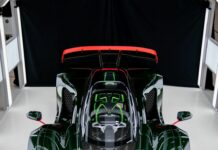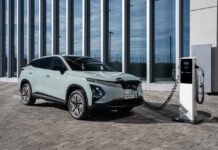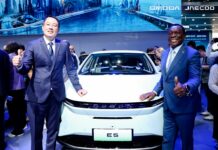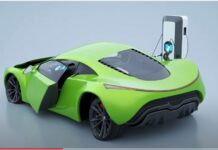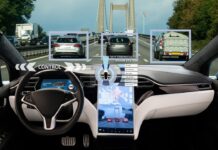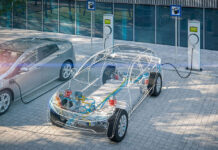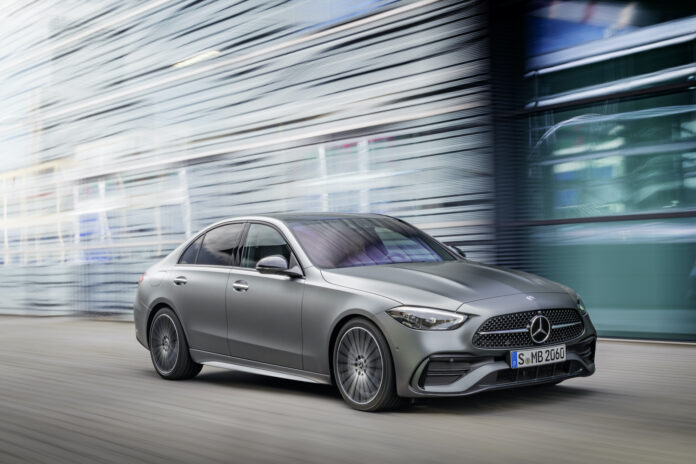
Welcome to a new, even more digital and efficient world, and welcome home: the new C-Class stands for both, and in all respects creates a future-proof comfort zone in a time of worldwide transformation. As the first classic model series from Mercedes-Benz, the new C-Class is electrified throughout thanks to plug-in hybrids and mild hybrids with 48-volt technology and integrated starter-generator. Due to a high-efficiency battery system, it achieves an electric range of about 100 kilometres (WLTP[1]) as a plug-in hybrid. That is unprecedented in this category to date. It also sets standards with respect to sustainability. And because the C-Class is one of the company’s highest-volume model series, this systematic electrification has a correspondingly strong effect on our carbon footprint. Other technical refinements include optional features such as DIGITAL LIGHT and rear-axle steering. The first units of the new C-Class Sedan are expected to arrive in the region by the second half of the year.
The new C-Class already looks to be in motion at a standstill with its dynamic proportions, thanks to the combination of short front overhang, long wheelbase and rear overhang. The sporty bonnet with power domes accentuates this urge of forward motion. The windscreen and passenger cell have been moved to the rear for these classic proportions known in the industry as “cab-backward design”. The preceding model was already a great step forward in terms of a high-value appeal in the interior, and the new C-Class goes even further with respect to modern luxury. The interior adopts highlights from the new S-Class, adding a sporty touch. Other features producing the sporty, superior appearance include the wide track and the flush 17- to 19-inch wheels in modern designs.The brand’s hallmark radiator grille characterises the front. All models feature a central star, with the design and character of the radiator grille differing in the details. The base model has a central star and louvres. In the AVANTGARDE line, there are additional decorative elements in the louvres, while the radiator grille and front apron feature chrome surrounds. The distinguishing feature of the AMG Line is the diamond grille with the star design in chrome.
The rear-end design is typical of a Mercedes-Benz sedan. The high-quality design of the tail lamps fascinates with an unmistakable day and night appearance. In the Sedan, the lamps for the first time have a two-piece design in the C-Class, with the light functions divided between the side wall and boot lid lamps. Their precisely configured interiors also showcase the standard of particularly high quality in detail. Optional or line-specific trim in the rear bumper attractively rounds off the rear view. Three new paint finishes – spectral blue, high-tech silver and opalite white – have been added to the colour range.
Interior design: sporty touches thanks to the driver-centred design
The dashboard is divided into an upper and a lower section: into a wing-like section with new, flattened round vents reminiscent of aircraft engine nacelles, and into an opulent expanse of trim. The latter flows from the centre console to the dashboard without interruption. Driver-focus adds to the sportiness: the dashboard and central display are slightly tilted towards the driver by six degrees.
The driver area features a high-resolution LCD screen. It is free-standing and appears to float in front of the wing profile and the expanse of trim. This sets the driver display apart from traditional cockpits with classic round dials. Customers have a choice between a 10.25-inch (26.0 cm) or a 12.3-inch (31.2 cm) version.
The paradigm change to digitisation is also obvious in the central display: the vehicle functions can be controlled using the high-quality touchscreen. Its portrait orientation is particularly advantageous for navigation. The touchscreen likewise appears to float above the expanse of trim. Like the dashboard, the screen is slightly tilted towards the driver. The central display has a screen diagonal of 9.5 inches (24.1 cm) as standard. A larger version measuring 11.9 inches or 30.2 cm is optionally available.
The special design of the optional AVANTGARDE or sport seats of the new C-Class uses layers and enveloping surfaces to create a visual impression of lightness. A dashboard covered with man-made leather and featuring nappa-look beltlines is available for the C-Class (optional equipment, standard with AMG Line). The range of available trim showcases innovative surfaces. These include new interpretations of open-pored veneers in brown tones and a black, open-pored wood veneer featuring fine inlays of genuine aluminium that follow the dashboard’s contours.
Latest generation of MBUX: intuitively operated and learning
Like the new S-Class, the new C-Class is equipped with the second generation of MBUX (Mercedes-Benz User Experience). The vehicle interior becomes even more digital and intelligent, as both the hardware and software have made great strides: Brilliant images on the LCD screens make it easy to control vehicle and comfort functions.
The driver display and media display offer a holistic, aesthetic experience. The information is presented in a clearly structured way. Mercedes-Benz developed a new display aesthetic for the S-Class, which now is systematically used as the basis for other models.
The look of the screens can be individualised with three display styles (Discreet, Sporty, Classic) and three modes (Navigation, Assistance, Service).
- In “Classic” style, the driver is welcomed with a familiar display environment. The proven display with two tubes and changing content between them provides all the information relevant to the driver.
- “Sporty” is dominated by the colour red, with dynamic design of the central rev counter.
- In “Discreet” style, the content is reduced to what is essential. In addition, both screens can be shown in seven colour schemes with the ambient lighting. This makes for an impressive colour experience in the interior.
- In “Assistance Mode”, the traffic situation is shown in real time supplemented with important display information.
The full-screen navigation was adopted from the S-Class, and gives the driver the best possible guidance on a journey.
Powertrain: systematic electrification of the modern four-cylinder engines
Thanks to systematic electrification and intelligent downsizing, the new C-Class sets new standards in efficiency. The engine range has only four-cylinder units from the current modular FAME (Family of Modular Engines) Mercedes-Benz engine family. Accordingly, the engine range plays a major role in the flexibility of the international production network, with needs-based electrification.
In addition to turbocharging, the petrol engines now have an integrated starter-generator (ISG) for intelligent assistance at low engine speeds as a mild hybrid of the second generation. This ensures outstanding power delivery. The ISG uses a 48 volt on-board electrical system that ensures functions such as gliding, boosting or energy recovery, and makes significant fuel savings possible. The engines also start very rapidly and comfortably as a result, so that the start/stop function is almost as imperceptible to the driver as the transition from gliding with the engine switched off to strong acceleration under engine power. When idling, the intelligent interaction between the ISG and the combustion engine ensures outstandingly smooth running.
Transmission: Automatic now standard across the board
The 9G-TRONIC transmission was developed further for adapting the ISG, and is installed in all C-Class models. The electric motor, power electronics and transmission cooler have now moved into or to the transmission. Previously required lines are eliminated, which offers advantages with regard to installation space and weight. In addition, the efficiency of the transmission has been increased. Amongst other things, the optimised interplay with the electric auxiliary oil pump reduces the delivery rate of the mechanical pump by 30 percent compared with the predecessor – good for efficiency. Furthermore, it uses a new generation of the fully integrated transmission control with multi-core processor and new design and connectivity technology. In addition to the increased computing power, the number of electric interfaces has been drastically reduced, and the weight of the transmission control has been cut by 30 percent compared with the predecessor.
Overview of Sedan models (petrol engines):
| C 180 | C 200 | C 300 | ||
| Displacement | cc | 1496 | 1496 | 1999 |
| Output | kW/hp | 125/170 | 150/204 | 190/258 |
| at | rpm | 5500-6100 | 5800-6100 | 5800 |
| Add. output (boost) | kW/hp | 15/20 | 15/20 | 15/20 |
| Peak torque | Nm | 250 | 300 | 400 |
| at | rpm | 1800-4000 | 1800-4000 | 2000-3200 |
| Add. torque (boost) | Nm | 200 | 200 | 200 |
| Acceleration 0-100 km/h | s | 8.6 | 7.3 | 6.0 |
| Top speed | km/h | 231 | 246 | 250 |
Fourth-generation plug-in hybrids will follow soon after the launch. Electrification is taking a great step forward while using the same base engines. With an electric output of 95 kW/(129 hp) and an all-electric range of around 100 kilometres (WLTP), the plug-in hybrid C-Class will operate in all-electric mode in many cases – and on many days without using the combustion engine at all. This is the two-litre variant of the ultra-modern M 254 four-cylinder engine. The complete package is not only very efficient, but also decidedly sporty.
The high-voltage (HV) battery has been developed in-house by Mercedes-Benz AG. It is part of a fourth-generation family of batteries and represents a logical evolution of the previous generation. It consists of 96 cells in a so-called pouch configuration. The battery has a total capacity of 25.4 kWh, thereby bringing about a significant increase in electrical range to around 100 kilometres. To account for the high energy density, the HV battery has an internal cooling system. The thermal management system can therefore control the operating temperature irrespective of the climate control in the vehicle interior. In addition to continuous operation in hot and cold regions, this also allows quick charging with direct current. Even when the battery is completely discharged, it can be fully charged in around 30 minutes using the optional 55 kW DC charger. A standard-fit 11 kW charger (depending on the market) is available for three-phase charging at a Wallbox connected to the domestic AC mains.
The driving experience: considerably more electric
All in all, the driving experience is significantly more electric. In view of the increase in electric range to around 100 kilometres, drivers will be able to cover most everyday journeys under electric power alone. The energy recovery function allows kinetic energy to be recuperated during deceleration or downhill driving, a process that has now also been improved in interaction with the hydraulic brake. The energy recovery output is now over 100 kW. The intelligent, route-based operating strategy activates the electric driving mode where this is most appropriate for the route. It takes into account such factors as navigation data, topography, speed limits and the traffic conditions for the entire planned route. A driver wishing to influence the energy recovery rate can do so directly in three stages controlled by rocker switches behind the steering wheel. This is possible in all driving modes except SPORT. In the driving mode D-, for example, the driver can experience the “one-pedal feeling”: When the driver takes his foot off the accelerator the vehicle slows down purely by electric means, to such an extent that the hydraulic foot brake is often not needed.
The operating strategy communicates with the sensors of the assistance systems and thus efficiently supports the driver in many driving situations. Over longer distances in urban areas, for instance, the car will prioritise electric driving. Two additional driving modes enable the driver to make particularly advantageous use of the plug-in powertrain:
- BATTERY HOLD: Maintaining the charge state of the high-voltage battery is given priority, e.g. when intending to drive in a city centre or green zone later; selection of the most suitable drive configuration by the hybrid powertrain system, depending on the driving situation and route.
- ELECTRIC: Electric driving up to 140 km/h, adjustable energy recovery tare in overrun mode, adaptation of Active Distance Assist DISTRONIC for electric driving, activation of the combustion engine using a pressure point of the accelerator pedal (kickdown)
Suspension: comfort and agility
The key components of the new, dynamically configured suspension are a new four-link axle at the front and a multi-link axle at the rear mounted to a subframe. The new suspension provides the basis for a high level of suspension, ride and noise comfort, agile handling and driving fun. The new C-Class is optionally also available with continuously adjustable damping and a sport suspension. Air suspension at the rear is standard for the Sedan model of the plug-in hybrid.
Rear-axle steering: more agile and dynamic
The new C-Class is especially agile and stable with the optional rear-axle steering and the accompanying, more direct steering ratio at the front axle. The steering angle at the rear axle is 2.5 degrees. This reduces the turning circle by 43 centimetres to 10.64 metres.
The driver also needs fewer turns of the steering wheel for full lock. With rear-axle steering, and depending on the drive concept, this requires 2.1 instead of 2.35 turns (rear-wheel drive with comfort steering).
At speeds below 60 km/h, the rear wheels steer in the opposite direction to the front wheels – and by up to 2.5° opposite to the front-axle angle during parking. Depending on the situation, this virtually shortens the wheelbase, and the vehicle is more manoeuvrable, light-footed and agile as a result. At speeds above 60 km/h, the rear wheels steer up to 2.5° in the same direction as the front wheels. This virtual increase in wheelbase has noticeable advantages in the form of improved handling stability and safety at high speeds, during fast lane-changes or sudden evasive manoeuvres.
Crash safety: fit for all global requirements
Together with the familiar PRE-SAFE® protection concepts for frontal and rear collisions, PRE-SAFE® Impulse Side (available in conjunction with the Driving Assistance Package Plus) forms a kind of virtual crumple zone that extends all around the vehicle. As only a limited crumple zone is available in a side impact, PRE-SAFE® Impulse Side (availability depending on selected equipment) can move the affected driver or front passenger away from the danger even before the crash as soon as the system detects that a side collision is immediately imminent. For this purpose, air chambers in the side bolsters of the front seat backrest are inflated in fractions of a second.
All in all, the safety concept of the C-Class is based on an intelligently designed body shell with a particularly rigid passenger cell and crash structures that deform in a specific way acting together with seat belts and airbag systems. In an accident, systems such as belt tensioners and airbags can be activated to protect the occupants as the situation demands. With the help of numerous numerical simulations, the vehicle structure was configured to ensure particularly good occupant protection in the event of a crash. In all aspects of the vehicle configuration that are relevant in an accident, the legal requirements were further bolstered by internal testing requirements and test criteria derived from the findings from real-life accident scenarios.
High-tech features: impressive comfort in terms of driving at night, climate control, and seats
The new C-Class is equipped with LED High Performance headlamps as standard. The DIGITAL LIGHT system familiar from the new S-Class is available as an option. This revolutionary headlamp technology allows new functions, e.g. the projection of guide lines or warning symbols onto the road ahead. The AIR-BALANCE Package provides an individual fragrance sensation in the interior. At the touch of a button or by voice command, the holistic “Fit & Healthy” approach of ENERGIZING Comfort provides a tangible experience of the different comfort systems in the S-Class, and features programmes that group them into worlds of experience.
The optional massage function of the front seats has been expanded to cover the entire back area: eight chambers in the backrest ensure an improved deep-tissue effect. A vibrating massage is also possible on the driver’s side, with four motors installed in the seat cushion. Seat heating in the rear is available for the first time in the Sedan models.
At the touch of a button or by voice command, the holistic “Fit & Healthy” approach of ENERGIZING Comfort provides a tangible experience of the different comfort systems in the S-Class, and features programmes that group them into worlds of experience. At the same time, the system creates a matching atmosphere in the interior – for example, invigorating in case of fatigue or relaxing in case of an elevated stress level. The ENERGIZING COACH suggests an appropriate fitness or wellness programme based on vehicle and trip data. It also factors the information about sleep quality and stress level into its intelligent algorithm if the driver has a suitable wearable. In plug-in hybrid models, it offers the “Power Nap” programme, which is useful e.g. when making a stop at a service station or to charge the battery. The programme has three phases – falling asleep, sleeping, waking – and can increase performance and provide new energy.
The AIR-BALANCE Package provides an individual fragrance in the interior – in line with personal preference and mood. Thanks to refreshing ionisation and filtering of the outside and interior air, it also helps to ensure improved air quality and a greater sense of well-being.
Dimensional concept and practical features: more space in the front and rear
With a length of 4751 mm and a width of 1820 mm, the Sedan models is considerably larger than its predecessor. The wheelbase has increased by 25 mm to 2865 mm. Both the front and rear passengers benefit from the increased exterior dimensions.
The good drag coefficient of the preceding model (Sedan: Cd 0.24) has been preserved despite the larger exterior dimensions.
Here are the most important dimensions:
| C-Class … | … Sedan | Preceding model | Diff. |
| Exterior dimensions (mm) | |||
| Length | 4751 | 4686 | +65 |
| Width | 1820 | 1810 | +10 |
| Width incl. exterior mirrors | 2033 | 2020 | +13 |
| Height | 1438 | 1447 | -9 |
| Wheelbase | 2865 | 2840 | +25 |
| Track, front[2] | 1582 | 1563 | +19 |
| Track, rear2 | 1594 | 1546 | +48 |
| Interior dimensions (mm) | |||
| Max. headroom, front, driver | 1041 | 1039 | +2 |
| Headroom, rear[3] | 955/952 | 942/942 | +13/+10 |
| Legroom, front | 1059 | 1059 | 0 |
| Legroom, rear | 914 | 893 | +21 |
| Elbow room, front | 1476 | 1454 | +22 |
| Elbow room, rear | 1477 | 1462 | +15 |
| Shoulder-room, front | 1430 | 1404 | +26 |
| Shoulder room, rear | 1411 | 1398 | +13 |
| Luggage capacity acc. to [4]VDA (L) | 455 | 455 | 0 |
Production: in a global network with digital cutting-edge technologies
The new C-Class will be produced in the Mercedes-Benz Cars plants in Bremen (Germany), Beijing (China) and East London (South Africa). The Bremen plant, the largest private employer in the region with a workforce of more than 12,000, is the lead plant for this model series for the international C-Class production plants, e. g. by offering digital training. In this way, the new C-Class will be flexibly integrated into ongoing series production around the world. Close, digitally supported cooperation between the employees in the global C-Class production network will allow a smooth production start-up in all the plants around the world.
The worldwide production network of Mercedes-Benz Cars provides maximum flexibility. The company is therefore well-positioned in volatile times with changing parameters. The ability to breathe is a major success factor, and to this end new technologies are integrated into production. One example of smart production in Bremen is digital shop floor management, which allows production data to be monitored in real time. The QUALITY LIVE system enables the employees to check the quality of every vehicle in real time on a clearly arranged user interface. QUALITY LIVE and digital shop floor management are part of the MO360 digital production ecosystem of Mercedes-Benz Cars.
From 2022, all Mercedes-Benz Cars and Vans plants will produce on a carbon-neutral basis. Many Mercedes-Benz plants already source their electrical power from renewable energy sources today, and this also applies to Bremen.
[1] The data are preliminary; the vehicle is not on sale yet. The stated figures are the measured “WLTP CO2 figures” in accordance with Article 2 No. 3 Implementing Regulation (EU) 2017/1153. The fuel consumption figures were calculated based on these figures. Power consumption and range were determined on the basis of Commission Regulation (EU) No. 2017/1151.
[2] With 225/50 R 17 tyres
[3] Without/with sliding/tilting sunroof
[4] The luggage capacity is reduced in the plug-in hybrid model.





